CRUISING THE RHINE AND MOSEL RIVERS – A BIT OF FRANCE
CRUISING THE RHINE AND MOSEL RIVERS
This is the second in a series of articles about cruising on the Rhine and Mosel Rivers
A BIT OF FRANCE
By Charles N. Stevens
Photos by Dolores Seidman
We wake up to a cloudy, hazy morning at the dock in Strasbourg, France. The air is so cold this morning that the river steams and wafts over the water in a light breeze. A large white swan paddles by, his proud head erect. It is so cold this morning that the swan must have goose bumps.
Leaving the ship shortly after eight, we take a long frigid walk to the end of the streetcar line. We huddle in the open station waiting for the trolley, the temperature close to 40 degrees. It finally arrives, a sleek ultra-modern machine that looks like a bullet train. We enjoy its warmth inside as we are whisked smoothly into the town center. We detrain here and walk to the Place de la Cathedral.
Like most European churches, the Notre Dame Cathedral is towering and gothic. The church is imposing as we look up at its single spire reaching for the low overcast sky, its reddish color subdued by the elements and the dull day. Inside, its vast interior is shadowy, its stained glass windows drab because of the cloudy day. We appreciate being inside, looking up at its spectacular rose window and, as a bonus, using its ancient stone walls as a refuge from the chilly wind outside. It is astounding to think about how old this church is, having been constructed from the 11th century to the 15th. It is the tallest still-standing church built entirely during the Middle Ages. Old sketches of Strasbourg show the spire of the church pointing upward far higher than any other structure in town, the authority of the church dominating all.
After our visit to the cathedral, we walk to a canal where we board a special, glass-enclosed boat for a tour of the city. Vision through the glass is perfect so that all the sights will be seen clearly. And it’s warm inside! As our boat glides through the old canal, we look up at 15th century half-timbered houses, an old opera house and finally more modern buildings. Parts of Strasbourg had been bombed during World War II, so some of the older structures were destroyed. One of the recently built structures is for the Parliament of the European Union, a huge modernistic building with a blue glass exterior. From here, television programs are broadcast in many different European languages. We also pass the futuristic glass building housing the International Institute of Human Rights and the European Court of Human Rights. The latter looks to us like the end of a gigantic pair of binoculars.
Strasbourg has changed hands several times, alternating between France and Germany according to the political climate. The Germans called it Strasburg. It is the second largest city on the Rhine and an important center for the river traffic. With the Parliament of the European Union, it is also a center for European governance.
On our way back to the tram that will take us”home”, we saunter through the shopping district. Most of the souvenirs have something to do with the stork, a bird that commonly builds its great stick nests all over Europe, but is especially revered in the Strasbourg area. Located in another part of town is Stork Park where Alsatian white storks gather in a refuge, a place where they can winter and reproduce in peace.
The tram arrives soon and takes us back to our ship where we can enjoy being warm again. It feels good to finally shed our cumbersome jackets and snow hats, the thought of a nice hot lunch overpowering. We begin with potato and sauerkraut with bacon soup, its warmth spreading through our bodies, thawing us out. The “Coq au vin” (chicken in wine sauce) warms us even more.
We are given the afternoon to go back into Strasbourg with our tram pass, to explore it more, but the clouds and the bone-chilling cold are too formidable. If we had been younger we might have braved it. It seemed more prudent to remain on the ship in our comfortable cabin reading a good book.
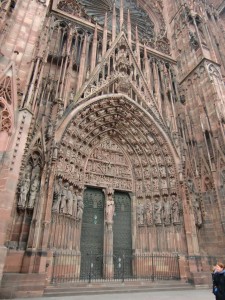
We stand before the magnificent entrance to the towering medieval cathedral in Strasbourg.
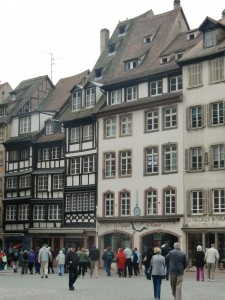
Parts of downtown Strasbourg look much as they would have during the Middle Ages.
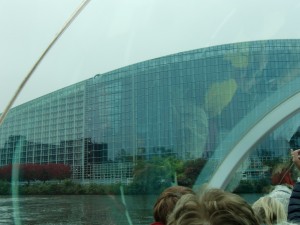
This futuristic blue glass building houses the Parliament of the European Union, making Strasbourg a political center for European countries.
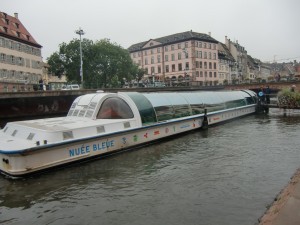
We rode on this excursion boat along Strasbourg's canals, giving great view of the city.
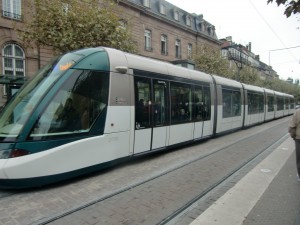
The bullet shaped trams in Strasbourg are the most modern ones we had seen. They give a very smooth ride.
MONTEREY PARK AUTHOR PUBLISHES 3RD BOOK ABOUT HIS EXPERIENCES IN WORLD WAR II- BACK FROM COMBAT
Charles “Norm” Stevens, a 40 year resident of Monterey Park and World War II Veteran has recently published the 3rd in his series about his experiences in WW II, Back from Combat: A WWII Bombardier Faces His Military Future. This book details the time from when he returned from combat in England where he flew 34 missions over Germany and France until the end of the war. Faced with large numbers of returning combat vets, and not knowing how long the war would continue, the military had to plan for their future. His options were whether to return to combat, become an instructor in the U.S., or receive new training that he would use in the Pacific. The book concludes with the end of the war with an Afterward that includes an update on the B-l7’s still flying in the U.S., as well as present day accounts pertaining to the war.
Stevens is the author of two previous books about his experiences:
An Innocent at Polebrook: A Memoir of an 8th Air Force Bombardier (Story of his 34 bombing missions from his base at Polebrook, England over Germany and France)
The Innocent Cadet: Becoming A World War II Bombardier (A prequel to the first, telling of his training in the U.S. before going overseas into combat.)
He is known to the readers of The Citizen’s Voice as the author of Travel Log Articles including “From Paris to Normandy on the Seine”, “Exploring New York” and “In Search of Snow.” He is retired, having taught for 32 years, primarily in the Montebello Unified School District.
Those interested in purchasing an autographed copy of any of his books, may contact the author at 323-721-8230 or Normstevens24@gmail.com.



